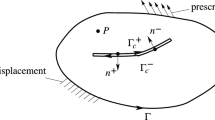Abstract
This paper presents a numerical approach for modeling the interaction between multiple cracks in a rectangular plate under cyclic loads. It involves the formulation of fatigue growth of multiple crack tips under mixed-mode loading and an extension of a hybrid displacement discontinuity method (a boundary element method) to fatigue crack growth analyses. Because of an intrinsic feature of the boundary element method, a general growth problem of multiple cracks can be solved in a single-region formulation. In the numerical simulation, remeshing of existing boundaries is not necessary for each increment of crack extension. Crack extension is conveniently modeled by adding new boundary elements on the incremental crack extension to the previous crack boundaries. As an example, the numerical approach is used to analyze the fatigue growth of three parallel cracks in a rectangular plate. The numerical results illustrate the validation of the numerical approach and can reveal the effect of the geometry of the cracked plate on the fatigue growth.
Similar content being viewed by others
References
Ingraffea, A.R., Blandford, G. and Liggett, J.A., Automatic Modeling of Mixed-Mode Fatigue and Quasi-Static Crack Propagation Using the Boundary Element Method. 14th Natl Symp on Fracture, ASTM STP 791, 1987, 1407–1426.
Blandford, G.E., Ingraffea, A.R. and Liggett, J.A., Two-dimensional stress intensity factor computations using the boundary element method. Int J Num Methods Eng, 1981, 17: 387–404.
Grestle, W.H., Finite and boundary element modeling of crack propagation in two and three-dimensions using interactive computer graphics. Ph.D Thesis, Cornell Univ, Ithaca, NY, 1986.
Doblare, M., Espiga, F., Garcia, L. and Alcanmd, M., Study of crack propagation in orthotropic materials by using the boundary element method. Eng. Fract. Mech., 1990, 37: 953–967.
Aliabadi, M.H., Boundary element formulation in fracture mechanics. Applied Mechanics Review, 1997, 50: 83–96.
Portela, A., Aliabadi, M.H. and Rooke, D.P., Dual boundary element incremental analysis of crack propagation. Int. J. Comput. Struct., 1993, 46: 237–247.
Mi, Y. and Aliabadi, M.H., Three-dimensional crack growth simulating using BEM. Int. J. Comput. Struct., 1994, 52: 871–878.
Mi, Y. and Aliabadi, M.H., Automatic procedure for mixed-mode crack growth analysis. Commun. Numer. Methods Eng, 1995, 11: 167–177.
Yan, X., An efficient and accurate numerical method of SIFs calculation of a branched crack. ASME J Appl. Mech. 2005, 72(3): 330–340.
Sih, G.C. and Barthelemy, B.M., Mixed mode fatigue crack growth prediction. Engineering Fracture Mechanics, 1980, 13: 439–451.
Erdogan, F. and Sih, G.C., On the crack extension in plates under plane loading and transverse shear. J. Basic Engineering, 1963, 85: 519–527.
Khan, A.S. and Paul, T.K.A., New model for fatigue crack propagation in 4340 steel. Int. J. Plasticity, 1994, 10: 957–972.
Khan, A.S. and Paul, T.K., A centrally crack thin circular disk, Part II: mixed mode fatigue crack propagation. Int. J. Plasticity, 1998, 14: 1241–1264.
Shi, H.J., Niu, L.S., Mesmacque, G. and Wang, Z.G., Branched crack growth behavior of mixed mode fatigue for an austenitic 304L steel. Int. J. Fatigue, 2000, 22: 457–465.
Lida, S. and Kabayashi, A.S., Crack propagation rate in 7075-T6 plates under cyclic tension and transverse shear loading. J. Basic Engineering, 1969, 91: 764–769.
Tanaka, K., Fatigue crack propagation from a crack inclined to the cyclic tension axis. Engineering Fracture Mechanics, 1974, 6: 493–507.
Otsoka, A., Mori, K. and Miyata, T., The condition of fatigue crack growth in mixed mode condition. Engineering Fracture Mechanics, 1975, 7: 429–439.
Yan, X., Du, S. and Zhang, Z., Mixed-mode fatigue crack growth prediction in biaxially stretched sheets. Eng. Fract. Mech., 1992, 43 (3): 471–475.
Charalambides, P.G. and McMeeking, R.M., Finite element method simulation of a crack propagation in a brittle microcracked solid. Mechanics of Materials, 1987, 6: 71–87.
Yan, X., Analysis of the interference effect of arbitrary multiple parabolic cracks in plane elasticity by using a new boundary element method. Computer Methods in Applied Mechanics and Engineering, 2003, 192(47–48): 5099–5121.
Yan, X., A numerical analysis of perpendicular cracks under general in-plane loading with a hybrid displacement discontinuity method. Mechanical Research Communications, 2004, 31(2): 175–183.
Yan, X., An effective method of stress intensity factor calculation for cracks emanating form a triangular or square hole under biaxial loads. Fatigue and Fracture of Engineering Materials and Structures, 2003, 26: 1127–1133.
Yan, X., A numerical analysis of cracks emanating from a square hole in a rectangular plate under biaxial loads. Eng Fracture Mech., 2004, 71(11): 1615–1623.
Yan, X., Interaction of arbitrary multiple cracks in an infinite plate. J Strain Analysis for Engineering Design, 2004, 39(3): 237–244.
Yan, X., Analysis for a crack emanating form a corner of a square hole in an infinite plate using the hybrid displacement discontinuity method. Appl Mathematics Modeling, 2004, 28(9): 835–847.
Yan, X., Cracks emanating from circular hole or square hole in rectangular plate in tension. Eng Fracture Mech, 2006, 73, 12: 1743–1754.
Yan, X., Stress intensity factors for asymmetric branched cracks in plane extension by using crack-tip displacement discontinuity elements. Mechanics Research Communications, 2005, 32(4): 375–384.
Yan, X., A numerical analysis of stress intensity factors at bifurcated cracks. Engineering Failure Analysis, 2006, 13(4): 629–637.
Yan, X., Microdefect interacting with a finite main crack. J Strain Analysis for Engineering Design, 2005, 40(5): 421–430.
Yan, X., A numerical analysis of cracks emanating from an elliptical hole in a 2-D elasticity plate. European J of Mechanics-A, 2006, 25(1): 142–153.
Crouch, S.L. and Starfield, A.M., Boundary Element Method in Solid Mechanics, with Application in Rock Mechanics and Geological Mechanics. London, George Allon & Unwin, Bonton, Sydney, 1983.
Murakami, Y., Stress Intensity Factors Handbook, Pergamon Press, Oxford, 1987.
Author information
Authors and Affiliations
Corresponding author
Additional information
Project supported by the National Natural Science Foundation of China (No. 10272037).
Rights and permissions
About this article
Cite this article
Miao, C., Yan, X. Interaction of Three Parallel Cracks in Rectangular Plate under Cyclic Loads. Acta Mech. Solida Sin. 26, 519–535 (2013). https://doi.org/10.1016/S0894-9166(13)60047-6
Received:
Revised:
Published:
Issue Date:
DOI: https://doi.org/10.1016/S0894-9166(13)60047-6



